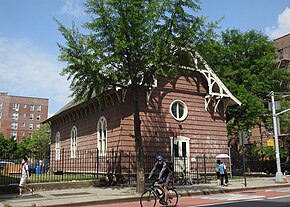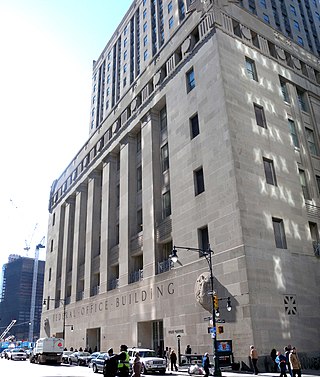Trinity Church is a historic parish in the Episcopal Diocese of New York, whose church is located at 89 Broadway opposite Wall Street, in the Financial District of Lower Manhattan in New York City. Known for its centuries of history, prominent location, distinguished architecture and bountiful endowment, Trinity's congregation is said to be "high church," its activities based on the traditions of the Episcopal Church and the worldwide Anglican Communion in missionary outreach, and fellowship. In addition to its main church, Trinity parish maintains two chapels: St. Paul's Chapel, and the Chapel of St. Cornelius the Centurion on Governors Island. The Church of the Intercession, the Trinity Chapel Complex and many other of Manhattan's Anglican congregations were once part of Trinity parish. Columbia University was founded on the church's grounds as King's College in 1754. To some, the congregation epitomizes White Anglo-Saxon Protestant culture in the United States.
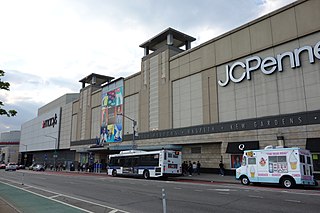
Elmhurst is a neighborhood in the borough of Queens in New York City. It is bounded by Roosevelt Avenue on the north; the Long Island Expressway on the south; Junction Boulevard on the east; and the New York Connecting Railroad on the west.

The Reformed Church of Newtown is a historic Reformed church in the Elmhurst neighborhood of Queens in New York City. The church was first established by Dutch immigrants in 1731. The neighborhood had been established in 1652 by the Dutch as Middenburgh, a village suburb of New Amsterdam. After the English took over the Dutch colony of New Netherland in 1664, the village was renamed New Town, later simplified to Newtown. When Newtown was renamed Elmhurst in the late 1890s, the church retained its original name, a name still also carried by the local high school and subway station.

St. Bartholomew's Church, commonly called St. Bart's, is a historic Episcopal parish founded in January 1835, and located on the east side of Park Avenue between 50th and 51st Street in Midtown Manhattan, in New York City. In 2018, the church celebrated the centennial of its first service in its Park Avenue home.

The Church of the Ascension is an Episcopal church in the Diocese of New York, located at 36–38 Fifth Avenue and West 10th Street in the Greenwich Village neighborhood of Manhattan New York City. It was built in 1840–41, the first church to be built on Fifth Avenue and was designed by Richard Upjohn in the Gothic Revival style. The interior was remodeled by Stanford White in 1885–88.

Grace Church is a historic parish church in Manhattan, New York City which is part of the Episcopal Diocese of New York. The church is located at 800–804 Broadway, at the corner of East 10th Street, where Broadway bends to the south-southeast, bringing it in alignment with the avenues in Manhattan's grid. Grace Church School and the church houses—which are now used by the school—are located to the east at 86–98 Fourth Avenue between East 10th and 12th Streets. In 2021, it reported 1,038 members, average attendance of 212, and $1,034,712 in plate and pledge income.

St. Paul's Chapel is a chapel building of Trinity Church, an episcopal parish, located at 209 Broadway, between Fulton Street and Vesey Street, in Lower Manhattan, New York City. Built in 1766, it is the oldest surviving church building in Manhattan, and one of the nation's finest examples of Late Georgian church architecture.

The Grand Avenue–Newtown station is a local station on the IND Queens Boulevard Line of the New York City Subway. Located under private property at the northeast corner of the intersection of Grand Avenue, Broadway, and Queens Boulevard in the neighborhood of Elmhurst, Queens, it is served by the R train at all times except nights, and the E and F trains at night.

The Church of Saint Mary the Virgin is an Episcopal Anglo-Catholic church in Midtown Manhattan, New York City, which is part of the Episcopal Diocese of New York of the Episcopal Church in the United States of America. The church complex is located in the heart of Times Square at 133-145 West 46th Street, with other buildings of the complex at 136-144 West 47th Street, between Sixth and Seventh Avenues. It is colloquially known as "Smoky Mary's" because of the amount of incense used in the services.
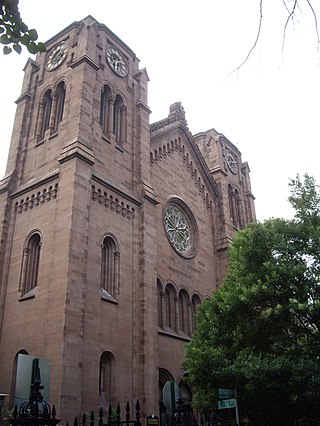
St. George's Episcopal Church is a historic church located at 209 East 16th Street at Rutherford Place, on Stuyvesant Square in Manhattan, New York City. Called "one of the first and most significant examples of Early Romanesque Revival church architecture in America", the church exterior was designed by Charles Otto Blesch and the interior by Leopold Eidlitz. It is one of the two sanctuaries of the Calvary-St. George's Parish.
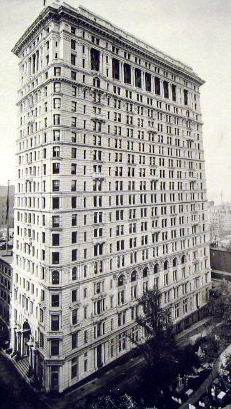
The Empire Building is an office skyscraper at 71 Broadway, on the corner of Rector Street, in the Financial District of Manhattan in New York City. It was designed by Kimball & Thompson in the Classical Revival style and built by Marc Eidlitz & Son from 1897 to 1898. The building consists of 21 stories above a full basement story facing Trinity Place at the back of the building and is 293 feet (89 m) tall. The Empire Building is a New York City designated landmark and is listed on the National Register of Historic Places (NRHP). It is also a contributing property to the Wall Street Historic District, a NRHP district created in 2007.

65 Broadway, formerly the American Express Building, is a building on Broadway between Morris and Rector Streets in the Financial District of Manhattan in New York City. The 21-story concrete and steel-frame structure, an office building, was designed by James L. Aspinwall of the firm Renwick, Aspinwall & Tucker in the Neoclassical style. 65 Broadway extends westward through an entire block, to Trinity Place. Its most prominent feature is its H-shaped building plan, with light courts located between its wings.

St. Andrew's Episcopal Church is a historic Episcopal church located at 2067 Fifth Avenue at 127th Street in the neighborhood of Harlem in Manhattan, New York City. Built in 1872, it was designed by noted New York City architect Henry M. Congdon (1834–1922) in the Gothic Revival style. It features a 125 foot tall clock tower surmounted by a slate covered spire surrounded by four towerlets.

St. James' Episcopal Church and Parish House is a historic Episcopal church at 2500 Jerome Avenue and 190th Street, in the Fordham neighborhood of The Bronx in New York City. It was founded July 5, 1853, becoming the first Episcopal parish in Fordham. The parish at first met at the Manor Reformed Church on Kingsbridge Road, then on June 11, 1854 acquired an old schoolhouse for use. On October 1, 1854, the Rev. Joshua Weaver became its first rector.

Grace Episcopal Church Complex is a historic Episcopal church complex at 155-15 Jamaica Avenue in Jamaica, Queens, New York City, in U.S. state of New York. The complex includes the church, parish house, and cemetery. The church was built between 1861 and 1862. It is constructed of rough-cut sandstone and features a steeply pitched roof and tall, sharp spire in the Gothic Revival style. A chancel, designed by Cady, Berg & See, was added at the rear of the church in 1901-1902. The parish house, known as Grace Memorial House, was built in 1912. It is three-story brick building in the Tudor Revival style. The surrounding cemetery includes burials dating to 1734, when the church located at this site. Notable interments include Rufus King (1755–1827), Charles King (1789–1867) and William Duer (1743–1799).

St. George's Church is an intercultural, multilingual Episcopal congregation in Flushing, Queens, New York City. With members from over twenty different nations of origin, it has served an ever-changing congregation since the 18th century. The current church building, constructed in 1854, is a New York City designated landmark on the National Register of Historic Places.
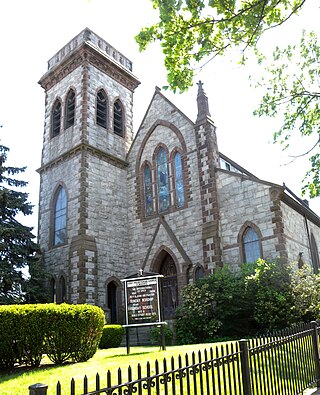
The First Presbyterian Church of Newtown is a historic Presbyterian church in the Elmhurst neighborhood of Queens in New York City. The church complex is composed of the main church, a parish hall, and a manse. The current complex at 54th Avenue, between Seabury Street and Queens Boulevard, is the fifth church complex built for the congregation.

Benevolent and Protective Order of Elks, Lodge Number 878 is a historic Elks lodge on Queens Boulevard in the Elmhurst neighborhood of Queens in New York City. The 3+1⁄2-story Italian Renaissance-style main building and two-story annex were both built in 1923–1924 and designed by the Ballinger Company. A three-story rear addition was added in 1930.
